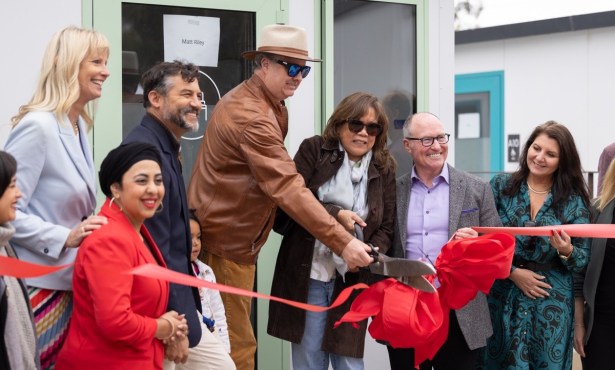Hey, Where’s the Train?
Frustration Spills Over About Lack of Commuter Rail

Italian dictator Benito Mussolini achieved fame for — among other things — “making the trains run on time.” It’s Scott Spaulding’s considerable challenge to change the time the trains run. Spaulding works for the clunkily acronymed Santa Barbara County Association of Governments (SBCAG) and has spent the better part of the last decade trying to allow Ventura residents get to their jobs in Santa Barbara — and there’re about 15,000 daily commuters — via enhanced rail service. Although the train tracks run flat along the coast, Spaulding’s path has been all uphill. But despite many false starts and setbacks, Spaulding — with 16 years as regional transportation planner with the agency — insisted, there’s good reason to believe progress can still be made.
Last week, Spaulding got an urgent earful from transportation activists wanting to know why it’s taken so long for commuter train service to be established. After all, they contended at a subregional meeting of the SBCAG board last Wednesday, it was promised, first in 2006 and again in 2008, when county residents voted overwhelmingly to tax themselves — in the form of Measure A — to expand the freeway and to get commuter rail.
“The deal was a lane and a train,” complained attorney Marc Chytilo, representing the Transit Futures Committee. “By 2010, we were supposed to have two trains back and forth from Camarillo to Santa Barbara. By 2016, we were supposed to have full service.” Chytilo, who successfully sued Caltrans and SBCAG over the adequacy of the environmental analysis for the freeway widening, argued that without the commuter train service, the freeway widening could not alleviate congestion along Highway 101. “Until we do that, we are just spinning our wheels,” he said.
Katie Davis from the Sierra Club also weighed in, urging local elected officials on the subregional board — who include Santa Barbara Mayor Helene Schneider, 1st District Supervisor Das Williams, 2nd District Supervisor Janet Wolf, and Carpinteria City councilmember Al Clark — to push harder. “Let’s think a little more aggressively and act a little more assertively,” she urged.
Mayor Schneider responded, “I feel your frustration,” and gave a brief recap of the convoluted process of negotiations that have transpired since. Union Pacific owns much of the tracks and by all reckonings has been tough to get at the bargaining table. When the railroad giant finally graced the bargaining table, she said, its demands proved excessive. At one point, she noted, the company demanded that local government agencies support the Phillips 66’s controversial oil train. The City of Santa Barbara, like many municipal governments along the coast, has embraced resolutions against the train, arguing that chemicals needed to keep the thick tarlike oil runny posed an unacceptable risk of explosion.
When county voters approved Measure A in 2008, $25 million in proceeds — roughly $1 million a year for the life of the bond — was set aside for train service. The idea was born of political necessity; without support from alt-transit advocates, Measure A could not pass, and without Measure A, there could be no freeway widening.
Efforts to jump-start negotiations for the rail service have involved no less than former Democratic presidential candidate — and former Massachusetts governor — Michael Dukakis. Union Pacific, headquartered out of Omaha, Nebraska, by reputation is famously impervious to political pressure. Former governor Arnold Schwarzenegger reportedly invited a Union Pacific official to Sacramento during his tenure in office, inviting him into the governor’s famous cigar tent and giving him a high-end stogie. The Union Pacific official reportedly thanked the governor, but he let the governor know Union Pacific existed before the State of California and would do whatever the company deemed in the company’s best interests.
Train advocates and transportation planners like Spaulding shifted their focus; they would work with Amtrak to retime when the Pacific Surfliner arrives in Santa Barbara. Currently it pulls into the station at 10:19 a.m., way too late for most work-a-day commuters. And it heads back from Goleta to points south at 4:22 in the afternoon, again too early to be commuter friendly. For a train to arrive in Santa Barbara at 8 a.m., it needs to leave Los Angeles, where it originates, about 5 a.m. For a whole lot of passengers who use that morning train to commute between Los Angeles and Ventura, such a schedule change would impose a significant hardship. As Spaulding explained it, there are two fixes. Both are complicated in the extreme. Neither is remotely easy.
The first requires a change in where a Santa Barbara-bound commuter train originates. By moving the origination point from Los Angeles to Moorpark, the negative impact to commuters traveling between Ventura and Los Angeles can be finessed. “It’s not like a bus,” Spaulding cautioned. “It’s very different.” First, a place to store the train is required. Crews have to be hired to clean it and service it. Neither of those now exist. Neither can be secured with Measure A’s $25 million in train money. The other solution is to run an additional train from Los Angeles early in the morning. Again, Spaulding explained, that’s not simple. Trains are exceptionally expensive, assuming there were any to buy, which, he added, there simply are not.
For either of these scenarios to pan out, Spaulding added, requires buy-in from a host of regional transportation providers, Metrolink, and Union Pacific, all of which have many competing demands on their limited track space and time. Navigating all the jurisdictions and stakeholders is akin to playing eight-dimensional chess. Despite such complexity, in the past two years, State Senator Hannah-Beth Jackson and California Transportation Deputy Director Chad Edison both believed they had reason to declare victory was at hand. Both would be proven unduly optimistic.
Last week, Spaulding told the subregional board he needed $50,000 to hire a private consultant to take another look at the options. What’s changed in the past two years, he explained later, sounds bureaucratically esoteric but is potentially profound. In the past, all the multiple stakeholders between San Diego and San Luis Obispo negotiated with Caltrans, which in turn negotiated with Amtrak for train service along the 750 miles of track. In August 2015, Spaulding explained, that changed. Caltrans was taken out of the equation and all the stakeholding agencies formed their own Joint Powers Agreement. This, he said, provides a level of local control that had hitherto been strikingly absent.
In addition, SBCAG itself has just experienced a change of leadership. Jim Kemp, who ran the agency for 14 years, just retired and was replaced by Marjorie Kirn, formerly executive director of the Merced County Association of Governments. There, Kirn ran a rail and bus service. Since taking over, she’s expressed full-throated support for commuter rail. What Kirn can accomplish has yet to be seen. If she fails, it won’t be for lack of effort, say her admirers within the public works bureaucracies. In her very first move since taking over, Kirn changed the chain of command at SBCAG. As of now, Scott Spaulding — SBCAG’s point person for trains and regional bus transit — reports directly to her.


